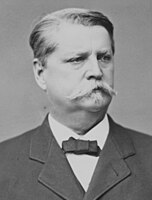Our website is made possible by displaying online advertisements to our visitors.
Please consider supporting us by disabling your ad blocker.
1880 United States presidential election
| |||||||||||||||||||||||||||||
369 members of the Electoral College 185 electoral votes needed to win | |||||||||||||||||||||||||||||
|---|---|---|---|---|---|---|---|---|---|---|---|---|---|---|---|---|---|---|---|---|---|---|---|---|---|---|---|---|---|
| Turnout | 79.4%[1] | ||||||||||||||||||||||||||||
| |||||||||||||||||||||||||||||
 Presidential election results map. Red denotes those won by Garfield/Arthur, blue denotes states won by Hancock/English. Numbers indicate the number of electoral votes allotted to each state. | |||||||||||||||||||||||||||||
| |||||||||||||||||||||||||||||
Presidential elections were held in the United States on November 2, 1880. Republican nominee James A. Garfield defeated Winfield Scott Hancock of the Democratic Party. The voter turnout rate was one of the highest in the nation's history. Garfield was assassinated during his first year in office, and he was succeeded by his vice president, Chester A. Arthur.
Incumbent President Rutherford B. Hayes did not seek reelection. After the longest convention in the party's history, the factionalized Republicans chose Representative Garfield of Ohio as their standard-bearer. The Democratic Party chose General Winfield Scott Hancock of Pennsylvania as their nominee. The dominance of the two major parties began to fray as an upstart left-wing party, the Greenback Party, nominated another Civil War general for president, Iowa Congressman James B. Weaver. In a campaign fought mainly over issues of Civil War loyalties, tariffs, and Chinese immigration, Garfield narrowly won both the electoral and popular vote. He and Hancock each took just over 48 percent of the popular vote, while Weaver and two other minor candidates, Neal Dow and John W. Phelps, together made up the remainder.
In the end, the popular vote totals of the two main candidates were separated by 1,898 votes (0.11%), the smallest victory in the national popular vote ever recorded. In the electoral college, however, Garfield's victory was much larger; he won the tipping point state of New York by 21,033 votes (1.91%). Hancock's sweep of the Southern states was not enough for victory, but it cemented his party's dominance of the region for generations.
This was the last of six consecutive presidential election victories for the Republican Party. It was also the first in which people in every state were able to vote directly for presidential electors.[a]
- ^ "Voter Turnout in Presidential Elections". The American Presidency Project. UC Santa Barbara.
Cite error: There are <ref group=lower-alpha> tags or {{efn}} templates on this page, but the references will not show without a {{reflist|group=lower-alpha}} template or {{notelist}} template (see the help page).
Previous Page Next Page
الانتخابات الرئاسية الأمريكية عام 1880 Arabic ھەڵبژاردنی سەرۆکایەتیی ویلایەتە یەکگرتووەکانی ئەمریکا (١٨٨٠) CKB Præsidentvalget i USA 1880 Danish Präsidentschaftswahl in den Vereinigten Staaten 1880 German Elecciones presidenciales de Estados Unidos de 1880 Spanish Yhdysvaltain presidentinvaalit 1880 Finnish Élection présidentielle américaine de 1880 French הבחירות לנשיאות ארצות הברית 1880 HE Elezioni presidenziali negli Stati Uniti d'America del 1880 Italian 1880年アメリカ合衆国大統領選挙 Japanese




